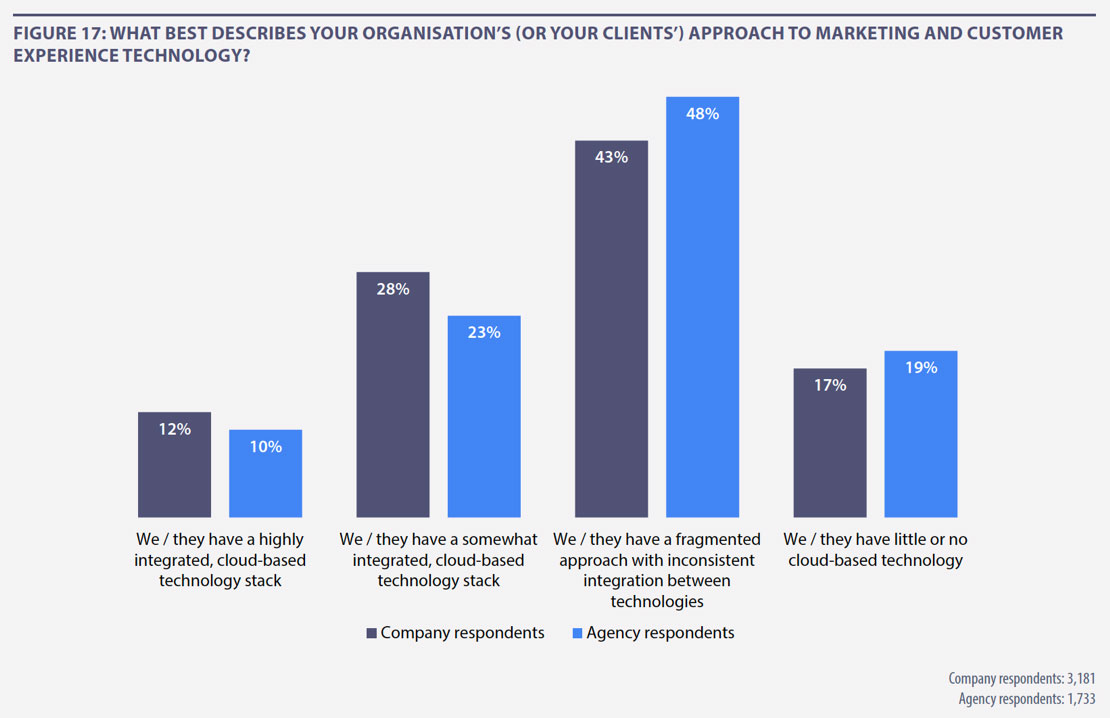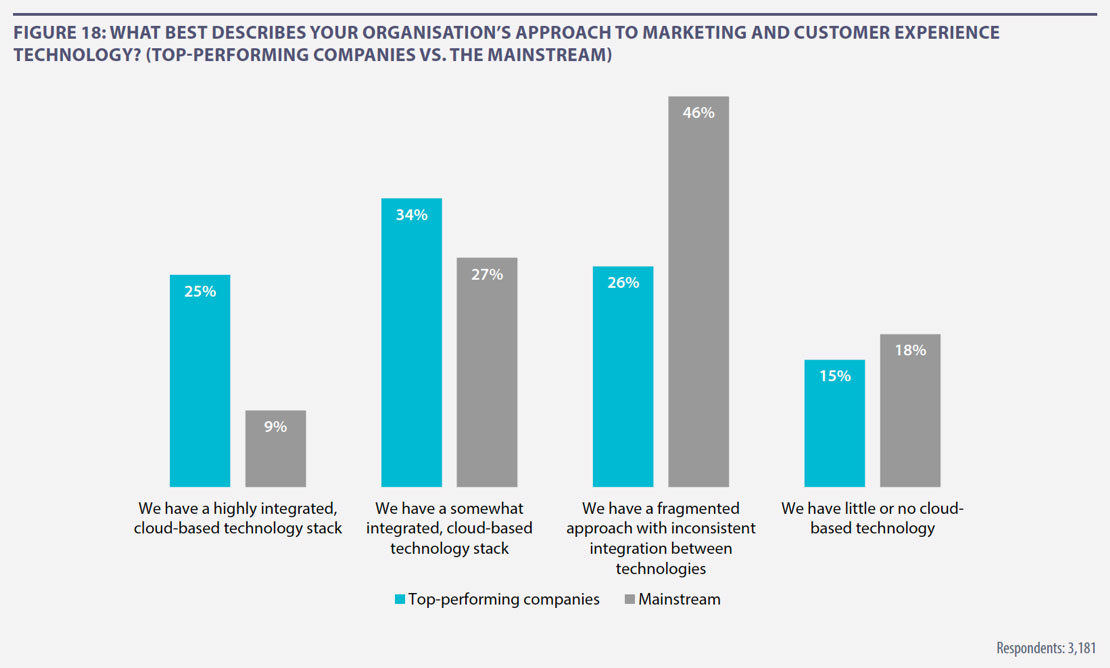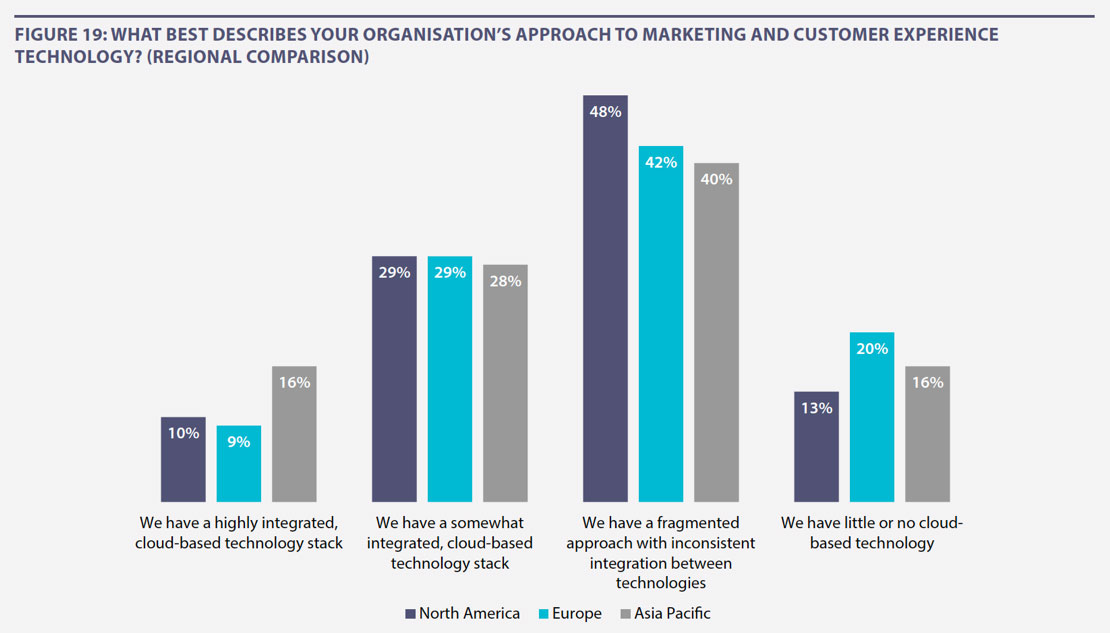Companies with integrated technology stacks outperform competitors
The nature of a company’s technology infrastructure can make or break its attempts to provide an optimal experience for customers across a growing number of channels and touchpoints. A new question introduced into this annual survey looks at the nature of the marketing and CX-related cloud technology setup used by companies, ranging from the highly integrated to the non-existent (Figure 17).
Organisations are most likely to have a fragmented approach with inconsistent integration between technologies, an unsatisfactory state of affairs indicated by 43% of company and 48% of agency respondents. A lack of integration reduces the chances of providing a seamless customer experience. It can also be frustrating for marketers and other employees who want to go about their jobs without unnecessary restrictions in their ability to acquire, retain and delight customers.
With an ever-growing number of marketing technology point solutions available (more than 5,000 at the last count10), it is no surprise that many companies are struggling to build the kind of unified platform that is increasingly a prerequisite for success.

In an interview with CMO.com last year11, Stephan Pretorius, Global CTO at ad agency group Wunderman, warned enterprises about adding point solutions without thinking about the overall marketing stack: “People often implement new tools without really thinking through how they need to be configured, how they need to be designed and, most importantly, how they need to connect into the broader marketing technology architecture and even the business process.”
Our research shows that a highly-integrated, cloud-based tech stack for marketing and customer experience requirements is very much possible, with 12% of respondents claiming to have this in place. It is also very much worth the effort. As can be seen in Figure 18, top-performing companies are almost three times more likely than their mainstream peers to have this kind of infrastructure in place (25% vs. 9%).

The rise of the marketing cloud owes much to greater levels of co-operation between the Chief Marketing Officer (CMO) and the Chief Information Officer (CIO), an important relationship axis that can define the success of the marketing and CX technology setup. Senior stakeholders need to be united in recognising the importance of an integrated technology stack in enabling a more unified approach to data and seamless customer experience across different points of engagement. A common customer profile and established rules for personalisation need to be available seamlessly, and within a secure technical environment, without any latency across campaigns and touchpoints.
To bring the concept of a unified customer experience to life, Heathrow Airport is a good example of a brand that has harnessed cloud technology to facilitate smoother customer interaction and frictionless experiences across its airport, rail, parking and retail operations12. Acxiom and Adobe’s Connected Spaces solution, rooted in technology and data, allows Europe’s busiest airport to deliver more personalised communications as part of a multichannel approach, resulting in a 22% increase in loyalty retail spending, 19% growth in loyalty membership, 20% growth in active membership, 34% increase in reactivated members and 23% increase in spending per visit.
According to Simon Chatfield, Head of eBusiness and CRM, Heathrow: “We aim to offer our customers a rich and varied experience, tailored to their specific needs. By connecting our data with retailers, airlines and other partners’ assets, we are able to recognise, better understand and creatively engage the growing number of customers who visit Heathrow each year.”
With consumer expectations growing all the time, no business can afford to rest on its laurels. Digital transformation is very much a journey rather than a destination, so the onus is o CMOs and CIOs to make sure they have a clear roadmap and technology in place for the rest of 2018 and beyond.
Figure 19 shows how organisations in different regions approach their technology. APAC respondents are more likely to have an integrated, cloud-based technology stack, with 16% of research participants in this region saying their companies have this in place, compared to 10% in North America and 9% in Europe.
